Wagner SprayTech Flexio 970 Sprayer Manuel utilisateur
- Catégorie
- Systèmes de pulvérisation fine Power
- Taper
- Manuel utilisateur

EnglishFrançaisEspañol
0617 • Form No. 0529682B
Owner’s Manual
Read this manual for complete instructions
Français (page 17) / Español (página 33)
Contents
2 Important Safety Information
4 Controls and Functions
6 Setup
7 Preparing to Spray
8 Power and Material Controls
9 Spray Pattern Adjustment
10 Proper Spraying Technique
12 Cleanup
16 Maintenance
16 Troubleshooting
49 Parts List
56 Warranty
Questions?
Call Wagner Technical Service at:
1-800-328-8251
Register your product online at:
www.wagnerspraytech.com

English
2 © Wagner Spray Tech - All Rights Reserved
Important Safety Information
Read all safety information before
operating the equipment. Save these
instructions.
Indicates a hazardous situation which,
if not avoided, could result in death or
serious injury.
To reduce the risks of re or explosion,
electrical shock and the injury to
persons, read and understand all
instructions included in this manual. Be
familiar with the controls and proper
usage of the equipment.
Grounding Instructions
This product must be grounded. In the event of an
electrical short circuit, grounding reduces the risk
of electric shock by providing an escape wire for
the electric current. This product is equipped with a
cord having a grounding wire with an appropriate
grounding plug. The plug must be plugged into an
outlet that is properly installed and grounded in
accordance with all local codes and ordinances.
WARNING - Improper installation of
the grounding plug can result in a risk
of electric shock.
If repair or replacement of the cord or plug is
necessary, do not connect the green grounding wire
to either at blade terminal. The wire with insulation
having a green outer surface with or without yellow
stripes is the grounding wire and must be connected
to the grounding pin.
Check with a qualied electrician or serviceman
if the grounding instructions are not completely
understood, or if you are in doubt as to whether the
product is properly grounded. Do not modify the
plug provided. If the plug will not t the outlet, have
the proper outlet installed by a qualied electrician.
This product is for use on a nominal 120 volt
circuit and has a grounding plug that looks like
the plug illustrated below. Make sure that the
product is connected to an outlet having the same
conguration as the plug. No adapter should be
used with this product.
Grounded Outlet
Grounding Pin
Cover for grounded outlet box
WARNING - To reduce the risk
of re or explosion:
1. Do not spray ammable or combustible
materials near an open ame, pilot lights
or sources of ignition such as hot objects,
cigarettes, motors, electrical equipment and
electrical appliances. Avoid creating sparks
from connecting and disconnecting power
cords.
2. For use with only water-based or mineral
spirit-type materials with a minimum ash point
of 100º F (38ºC) — Do not spray or clean with
liquids having a ash point of less than 100º F
(38ºC). Flash point is the temperature at which
a uid can produce enough vapor to ignite.
3. Verify that all containers and collection systems
are grounded to prevent static discharge.
4. Connect to a grounded outlet and use
grounded extension cords (electric models
only). Do not use a 3 to 2 adapter.
5. Keep spray area well ventilated. Keep a good
supply of fresh air moving through the area
to keep the air within the spray area free from
accumulation of ammable vapors.
6. Do not smoke in the spray area.
7. Do not operate light switches, engines, or
similar spark producing products in the spray
area.
8. Keep area clean and free of paint or solvent
containers, rags, and other ammable materials.
9. Know the contents of the paint and solvents
being sprayed. Read all material Safety Data
Sheets (SDS) and container labels provided with
the paints and solvents. Follow the paint and
solvent manufacture’s safety instructions.
10. Fire extinguisher equipment shall be present
and working.

English
© Wagner Spray Tech - All Rights Reserved 3
Important Safety Information
WARNING - To reduce the risk of
injury:
1. Always wear appropriate gloves, eye protection,
clothing and a respirator or mask when
painting. Hazardous vapors – Paints, solvents,
insecticides, and other materials can be harmful
if inhaled or come in contact with body. Vapors
can cause severe nausea, fainting or poisoning.
2. Do not operate or spray near children. Keep
children away from equipment at all times.
3. Do not overreach or stand on an unstable
support. Keep eective footing and balance at
all times.
4. Stay alert and watch what you are doing.
5. Do not operate the unit when fatigued or under
the inuence of drugs or alcohol.
6. Never aim spray gun at any part of the body.
7. Follow all appropriate local, state, and national
codes governing ventilation, re prevention,
and operation.
8. The United States Government Safety Standards
have been adopted under the Occupational
Safety and Health Act (OSHA). These standards,
particularly part 1910 of the General Standards
and part 1926 of the Construction Standards
should be consulted.
9. Use only manufacturer authorized parts. User
assumes all risks and liabilities when using parts
that do not meet the minimum specications
and safety devices of the turbine manufacturer.
10. Power cord must be connected to a grounded
circuit.
11. Do not spray outdoors on windy days.
WARNING - To reduce the risk of
electric shock:
1. Always remove turbine before cleaning.
2. Power cord must be connected to a grounded
circuit.
3. Never submerge electrical parts in liquids.
4. Never expose the equipment to rain. Store
indoors.
5. Keep electrical cord plug and spray gun trigger
free from paint and other liquids. Never hold
the cord at plug connections to support the
cord. Failure to observe may result in an
electrical shock.
6. The electrical cord has been specially designed
to safely carry the electrical load of this system.
Do not use other non FLEXIO 970 HVLP turbines
in conjunction with this unit.
Important Electrical
Information
Use only a 3-wire extension cord that has a 3-blade
grounding plug and a 3-slot receptacle that will
accept the plug on the product. Make sure your
extension cord is in good condition. When using an
extension cord, be sure to use one heavy enough
to carry the current your product will draw. An
undersized cord will cause a drop in line voltage
resulting in loss of power and overheating. A
14 gauge or 12 gauge, 25-foot 300V cord is
recommended. If an extension cord is to be used
outdoors, it must be marked with the sux W-A
after the cord type designation. For example, a
designation of SJTW-A would indicate that the cord
would be appropriate for outdoor use.
IMPORTANT:
Household use only. Intended
for indoor/outdoor use ONLY with materials
having ashpoint above 100ºF (38ºC).
Thank you for your purchase!
Thank you for purchasing the Wagner FLEXiO sprayer with best-in-class features
that are designed for spraying residential paint, un-thinned, indoors or out. Only
the FLEXiO sprayers have the power of the X-Boost® turbine and versatility of the
iSpray nozzle that will help you nish projects fast and professionally. They are
easy to use right out of the box and with low overspray and less clogging you will
enjoy the exibility to tackle all the painting projects on your list. We appreciate
your feedback, so please visit our website and write a review on the FLEXiO
handheld sprayer so we can continue to learn and improve our products.
Just click on www.wagnerexio.com
If you have any questions about your FLEXiO sprayer, please call Technical
Service at 1-800-328-8251. See www.wagnerspraytech.com in the “Contact
Us” section for Technical Service hours.

English
4 © Wagner Spray Tech - All Rights Reserved
Controls and Functions
Spray width
lever
X-Boost™ power dial
X-Boost™ turbine
Filter housing (both sides)
Suction tube
holder / paint can
attachment bracket
To turbine
power cord
(14.5 f
t)
ON / OFF
switch
Fluid pump
2-Stage trigger
Turbine
power
cord
Suction tube
Material ow control
Adjustment ring
Spray nozzle
Clip attachment
Paint hose
To paint
hose/nozzle
Spray Process
With this spray system, the uid pump delivers material through the paint
hose to the spray nozzle. At the spray nozzle, the material is atomized
(sprayed) by the air provided by the turbine.
For a more detailed outline of the sprayer controls, refer to pages 8-9.

English
© Wagner Spray Tech. - All Rights Reserved 5
Controls and Functions
Fluid Pump:
The uid pump delivers material from the
material container to the spray nozzle via the
paint hose.
X-Boost Turbine:
The X-Boost Turbine supplies the air that
forces the material out of the spray nozzle.
When plugged in, power to the turbine is
provided by pulling the trigger.
iSpray Nozzle:
Designed for spraying thicker materials, such
as latex paints and stains. Spraying with this
nozzle will leave a slightly coarser nish that
is between a roller and ne-nish sprayer.
a
b
Adjustment ring
The spray pattern shape is adjusted by
turning the adjustment ring (a) to either the
vertical or horizontal positions.
Make sure the black retaining ring (b) is
not loosened.
ON/OFF Switch:
The ON/OFF switch on the uid pump turns
power to the system on and o.

English
6 © Wagner Spray Tech. - All Rights Reserved
Setup
Before you begin
NEVER point the spray gun at any part
of the body.
IMPORTANT: Make sure the power cord is
unplugged.
Setup
Note: Make sure the system is placed on a level, clean
surface. Follow these instructions for both one-gallon
and ve-gallon containers.
1. Lift up the suction tube holder as far as it will go.
2. Position the material container next to the pump
assembly as shown. The container handle (a) should
be vertical and placed in between the two suction
tube guides.
Slide the suction tube
holder
(b) down until it
touches the top of the material container.
The
container is now secured to the pump and the entire
unit can be carried by the container handle.
IMPORTANT: The container handle must be placed
between the two suction tube guides, or the
container will tip when carried due to the added
weight of the pump assembly.
3. Place the suction tube back into position in the
suction tube guide. Make sure the tube reaches the
bottom of the material container.
b
a
2
1
3
Watch Setup:
www.wagnerspraytech.com/Flexio970

English
© Wagner Spray Tech - All Rights Reserved 7
Preparing to Spray
Note: Before spraying, you will need to prime the
system (deliver material from the container to the
spray nozzle via the paint hose). Follow the steps
below.
You Will Need:
• Waste bucket
• Drop cloths to protect oors and furnishings from
overspray
Preparing to Spray
1. Point the spray nozzle into the side of an empty
waste container.
Squeeze and hold the trigger for the next steps.
Note: Point the sprayer to the side of the waste
container to minimize overspray.
2. Turn the ON/OFF switch to ON.
Material will begin to ow from the container into
the paint hose. Air will blow from the spray nozzle.
3. Continue to squeeze the trigger until the material is
owing freely from the spray gun.
The system is now primed and you are ready to
spray.
Note: If the sprayer has been used before, some
cleaning solution may be left in the paint hose from
previous cleanings. Squeeze the trigger until all air
and cleaning solution is purged from the hose and
material is spraying from the nozzle.
Note: The uid pump will cycle ON and OFF while
spraying to regulate pressure. This is normal.
1
2
3
ON

English
8 © Wagner Spray Tech - All Rights Reserved
Power and Material Controls
Watch Painting:
www.wagnerspraytech.com/Flexio970
Spray performance will depend upon a number of
factors: material thickness, air power, spray pattern
selected, and material ow. Testing dierent
variations of the control settings will help you
achieve the desired results. See descriptions and
suggested Power and Material Settings Guide below
to help with your project.
X-Boost™ Power Dial
The X-Boost™ power dial adjusts the level of air
pressure produced by the turbine. The X-Boost™
power dial is factory-set at maximum out of the box.
• The “HI” air power level will result in faster
coverage and a smoother nish with thicker
materials.
• The “LO” air
power
will result in larger drops of
material being sprayed from the gun, and will
create a slightly rougher nish.
+
-
Tip: The thicker the material you are spraying,
the higher the turbine
power
you will need. Thick
materials will spray on coarse and smooth out as it
dries.
Tip: For ne-nish work with thinner materials, you
may want to decrease the air
power
. Spraying a
thinner material at high air
power
will result in more
overspray. Overspray is sprayed material that does
not stick to the spray surface and bounces back.
Material Flow Control
The material ow control determines the amount of
spray material that is sprayed from the spray gun.
Set the material ow by turning the knob on the
body of the spray nozzle.
• For thicker materials, it is recommended that
you start with the material ow setting on HI.
• For thinner materials, it is recommended that
you start with the LO material ow setting, and
increase the ow if needed.
• The higher the ow setting, the quicker you will
have to work in order to avoid drips and sags in
your spray pattern.
Tip: Spraying with the control set too high will
result in a spray pattern that runs and sags (too
much material).
Tip: Spraying with the control set too low will result
in a spray pattern that does not cover (not enough
material).
Tip: To ensure desired results are achieved with the
controls, test your spray pattern on the spray poster
or a scrap piece of wood or cardboard.
Power and Material Settings Guide
Coating
iSpray Nozzle
Material Flow Air Power
Transparent / semi-transparent stains, sealers 1-3 LO
Lacquers (water based) 1-4 LO
Solid stains 3-7 LO
Polyurethane 5-8 HI
Oil enamels 9-10 HI
Latex paints plus primers, Latex paints 9-10 HI
Oil or latex primers 9-10 HI
* Thinning may be necessary to speed up spraying.

English
© Wagner Spray Tech - All Rights Reserved 9
Spray Pattern Adjustment
Adjust Spray Shape
The spray pattern shape is adjusted by turning the
adjustment ring to either the vertical or horizontal
positions. The positions of the air cap and the
corresponding spray pattern shapes are illustrated
below.
Test each pattern and use whichever pattern is
suitable for your application.
NEVER trigger the gun while
adjusting the adjustment ring.
NEVER point the spray gun at any
part of the body.
Adjustment ring
Horizontal pattern
=
=
=
Use ‘up and down’
spraying motion
Vertical pattern
=
=
=
Use ‘side to side’
spraying motion
IMPORTANT: When changing the spray
pattern, make sure the black retaining ring is
not loosened.
Adjust Spray Width
The spray width lever on the iSpray nozzle
determines the width of the spray pattern.
Spray width lever
Wide
pattern
For coating large surfaces
Use higher air power
Use higher material ow
Narrow
pattern
For coating smaller areas,
corners and edges
Use lower air power
Use lower material ow
Note: Make sure the width lever is rmly set in
either one of these positions. If it is between
positions, the spray pattern will be disrupted.
Tips:
1. Start with a fan pattern for painting trim work
(1-5” width) and larger surfaces like doors and
walls (>5” width).
2. Adjust Material & Air Flow settings as shown in
chart based on coating, fan pattern width, and
nozzle.
3. Fine tune the Material and Air Power settings to
achieve the best results for your application.
4. Pull trigger slightly to start the turbine before
pulling all the way to spray material.
5. Use narrow pattern for detailed work, touch up.
6. Recommended settings for Material and Air
Power may change if the coating is thinned.

English
10 © Wagner Spray Tech - All Rights Reserved
Proper Spraying Technique
STOP
The room you are spraying must be properly
masked in order to prevent overspray from
covering woodwork, oors or furnishings.
Make sure you have properly masked the
room per the instructions on the enclosed
“Taping Guide”.
If spraying with a paint sprayer is new or unfamiliar
to you, it is advisable to practice on a piece of scrap
wood or cardboard before beginning on your
intended workpiece and/or test with water.
Keep Container Filled!
Periodically check the material container to make
sure the suction tube and inlet lter is submerged in
the material.
If your spray job requires more than one container of
material, it is recommended that the new container
be poured into the container that is secured to the
unit. This will keep the inlet lter submerged and
prevent air from entering the system.
If you accidentally run out of material, you will need
to follow the “Preparing to Spray” instructions on
page 7 to re-prime the system.
Spray Poster
A spray poster is included with your unit. The spray
poster can be adhered to a spraying surface and can
be used for practice. Follow the guidelines on the
poster.
Surface Preparation
All objects to be sprayed should be thoroughly
cleaned before spraying material on them. Areas
not to be sprayed may, in certain cases, need to be
masked or covered.
Spray Area Preparation
The spray area must be clean and free of dust in
order to avoid blowing dust onto your freshly
sprayed surface.
How to Spray Properly
STOP
It is important to keep your arm moving
whenever the gun is being triggered. If
you pause or linger in one spot too long,
too much material will be sprayed to the
surface.
STOP
Partially pulling the trigger will start
the turbine, but no material will spray
until the trigger is pulled fully. It is
recommended that the trigger rst be
pulled partially in order to start the
turbine before a spray pass is made.
• Position the spray gun perpendicular to and six
(6) to eight (8) inches from the spray surface,
depending upon the spray pattern size desired.
With reduced material ow and air power, you
can get closer to the spraying surface.
• Spray parallel to the surface with smooth passes
at a consistent speed as illustrated below.
Doing this will help avoid irregularities in the
nish (i. e. runs and sags).
6 to 8 inches
Correct
Even coat throughout
Keep stroke smooth and at an even speed
• Always apply a thin coat of material on the rst
pass and allow to dry before applying a second,
slightly heavier coat.
• When spraying larger surfaces, overlap each
spray pass by at least 50% This will ensure full
coverage.
• When spraying, always trigger the spray gun
after spray pass has begun and release trigger
before stopping the pass. Always keep the
gun pointed squarely at the spray surface and
overlap passes slightly to obtain the most
consistent and professional nish possible.
Incorrect
Do not ex wrist while spraying.
Light coat Heavy coat Light coat
STOP
During a project, periodically wipe the
nozzle tip with a cloth to remove any
dried paint.
Note: When you quit spraying for any length of
time, switch o the pump / unplug the sprayer.
When you restart, wipe the nozzle with a damp
cloth to remove any dried paint.

English
© Wagner Spray Tech - All Rights Reserved 11
Proper Spraying Technique
Pattern Examples
Use the images and guidelines below in order to
assist you in achieving the desired spray pattern for
your project. These are meant to be general starting
points - you may have to slightly modify certain
controls on the system in order to get the exact
performance you need.
Note: It is recommended that the trigger rst be
pulled partially in order to start the turbine before
a spray pass is made.
STOP
During a project, periodically wipe the
nozzle tip with a cloth to remove any
dried paint.
Large Surface Projects
Generally, high material ow and air power are
needed for spraying large surface areas, such as walls
and decks.
The iSpray nozzle is ideal for these applications and
is designed for broad coverage in either horizontal
or vertical spraying. Make sure the spray width lever
is set to the wide setting.
• The air cap position will determine the
movement direction of the spray gun.
Small Surface Projects
Generally, low material ow and air power are
needed for spraying smaller surface areas, such as
corners, lattice, or spindles.
For this type of project, reduce power, material ow
and switch to a narrow width when using the iSpray
nozzle.
• If you feel the material is going on too thin,
increase the material ow.
• If you feel the material is going on too thick,
decrease the material ow even further or move
the spray gun further away from the surface.
Note: If after following the guidelines on
these two pages you are still not getting the
spray performance you need, refer to the
‘Troubleshooting’ section on page 16.
Besides adjusting the controls, other factors that
should be considered when spraying:
• Distance from the spray object - if you are too
far from the spraying surface, the material will
go on too thin, and vice versa.
• Material thickness - if the spray pattern runs
and/or is too splotchy, the material may need to
be thinned.
Note: Only thin the material if absolutely
necessary to improve spray performance. Optimal
spray performance should be acheived simply by
adjusting the various controls on the unit.
If the material needs to be thinned, dilute the
material in steps of 5% - 10% until the desired
spray pattern is acheived.
• Spray gun movement - moving the gun too
quickly will cause the spray pattern to be too
thin and excess overspray. Moving the gun too
slowly will cause the spray pattern to be too
coarse or thick.
=

English
12 © Wagner Spray Tech - All Rights Reserved
Cleanup
Purging the Paint Hose
Before you begin
IMPORTANT: Make sure a drop cloth is placed
underneath the pump and material container to catch
any drips.
To Purge the Paint Hose
1. Turn the ON/OFF switch to OFF.
Lift the suction tube holder up a few inches. Allow
the suction tube to come up so that it is no longer
submerged in the material, but leave it in place within the
suction tube holder.
2. Push the tab below the trigger (a), twist and separate the
nozzle from the turbine. Wipe the exterior of the nozzle
until clean.
Open the velcro strap at the paint hose and separate the
power cord from the hose.
Do not submerge or allow the turbine to come
into contact with any liquids.
3. Using the clip attachment, hook the nozzle onto the
empty suction tube holder (the one that does not
currently have the suction tube in it) as shown. The front
of the nozzle should be pointing directly into the material
container.
4. Turn the material ow control knob to 12. Pull the trigger
backwards and pull out the trigger stop (b).
Note: The material ow control knob must be set to 12 in
order for the trigger stop to move out.
5. Turn the ON/OFF switch to ON. Allow the pump to run
until all paint is purged from the spray hose.
Turn the pump OFF. Leave the trigger stop in place for
the next steps.
1
3
5
a
2
b
4
Watch Cleanup:
www.wagnerspraytech.com/Flexio970

English
© Wagner Spray Tech - All Rights Reserved 13
Cleanup (continued)
Flushing the Nozzle
Before you begin
• If you sprayed using latex materials, you will need a 1- to
5-gallon container lled with warm, soapy water.
• If you sprayed oil-based materials, you will need a bucket
lled with approximately 1 quart of mineral spirits.
Special cleanup instructions for use with
flammable solvents (must have a flashpoint
above 100ºF (38ºC):
• Alwaysushspraygunoutside.
• Areamustbefreeofammablevapors.
• Cleaningareamustbewell-ventilated.
• Donotsubmergeturbine!
To Flush the Direct Feed iSpray Nozzle
1. Remove the material container from the pump (you may
have to lift up the suction tube holder to make room).
2. Replace the material container with a bucket of the
appropriate cleaning solution (see “Before you begin”,
above). Lower the suction tube holder and submerge the
suction tube into the cleaning solution.
Note: The spray nozzle should now be pointed directly
into the container of cleaning solution.
Turn the pump ON and allow cleaning solution to
circulate for approximately 5 minutes.
3. After 5 minutes, while pump is running, remove suction
tube from the cleaning solution and allow the solution to
purge from the nozzle and paint hose.
Turn the pump OFF.
4. Repeat steps 2 and 3 twice using new cleaning solution
each time. At the end of the third ushing, remove
the suction tube from the holder, and raise it up so it is
vertical. This will allow all uids to be purged.
Keep the pump running for the next step.
Note: The suction tube may no longer be clear due to
residual spray material. This is normal and will not aect
future performance of the unit.
5. Empty the paint hose of cleaning solution:
a. Starting as close to the pump as you can, lift the paint
hose above the level of the nozzle.
b. “Walk” the hose through your elevated hands until
you reach the nozzle. This allows gravity to fully drain
the hose of all liquids.
c. Shut the pump OFF.
6. Make sure to push the trigger stop back into the trigger
to release the trigger.
1
3
2
4
CLEANING
SOLUTION
X 2
CLEANING
SOLUTION

English
14 © Wagner Spray Tech. - All Rights Reserved
Cleanup (continued)
Cleaning the Regulator
Note: Removing and cleaning the regulator is necessary
to keep your sprayer from clogging or from producing an
irregular spray pattern.
To Clean the Regulator
1. Remove the paint hose (a) from the nozzle and remove
the cover (b).
2. Pull out the red catch and remove the pressure reducer
(c).
3. Remove the valve (d) and clean thoroughly.
4. Clean the openings in the pressure reducer using a brush
and water. Replace the valve removed in step 3.
5. Replace the pressure reducer into the spray nozzle and
secure with the red catch.
Note: Make sure the red seal (e) is in place prior to
reinstallation.
6. Place the cover onto the spray nozzle and replace the
paint hose.
a
b
c
d
1
2
e
1
2
4
6
3
5

English
© Wagner Spray Tech. - All Rights Reserved 15
Cleanup (continued)
Cleaning the Nozzle
To Clean the Nozzle
1. Remove the adjustment ring (a) carefully from the connecting
nut (b). Loosen the connecting nut.
2. Remove the parts as shown. Clean all parts with a cleaning
brush and the appropriate cleaning solution.
Note: Inside the nozzle (1) is a nozzle seal. If it comes o of
the nozzle, replace it back inside the nozzle with the groove
facing out as it is replaced.
3. Clean the rear of the nozzle (c) with the appropriate cleaning
solution. Use a thin layer of petroleum jelly to lubricate the
O-ring (d).
4. Reassemble the nozzle parts.
Insert the nozzle (1). Make sure to align the groove (e) and
notch (f) and align the nozzle opening with the needle.
5. Put the air screen (g) in the air cap (h). Put both
(2)
on the
nozzle
(1)
and secure with the connecting nut
(3)
.
Note: This step is easier if the iSpray nozzle is facing up.
6. Snap the adjustment ring
(4)
into the connecting nut
(3)
, enabling the adjustment lever (i) on the peg (j) to be
positioned in the air cap.
Note: Make sure that the two recesses on the adjustment
ring are engaged in the air cap tabs.
7. Reattach the nozzle to the turbine.
a
b
c
d
1
2
3
e
1
f
4
2
3
1
g
h
5
4
3
j
i
6
Groove

Troubleshooting
English
16 © Wagner Spray Tech - All Rights Reserved
Maintenance
Cleaning the Filters
IMPORTANT: Before every use, you should
inspect the air lters in the turbine to see if it
is excessively dirty. If it is dirty, follow these
steps to replace it.
IMPORTANT: Never operate your unit
without the air lters. Dirt could be sucked in
and interfere with the function of the unit.
1. Unplug the spray gun. Push the snap levers (a)
on the two turbine covers and remove them.
Remove the dirty lters and rub them between
your hands to remove collected paint. If this
does not help, replace with new ones. The
smooth side of the air lter must be placed
toward the turbine. Secure the covers back
onto the turbine.
PROBLEM CAUSE SOLUTION
Problem A: Little or no
material ow
1. Nozzle clogged.
2. Material ow setting too low.
3. Air lter clogged.
4. Spray material too thick.
1. Clean.
2. Increase material ow setting.
3. Change
4. Thin*.
Problem B: Material
leaking
1. Nozzle loose.
2. Nozzle worn.
3. Material build-up on air cap and
nozzle
1. Tighten retaining ring.
2. Replace.
3. Clean.
Problem C: Spray pattern
too thick, runs and sags
1. Material ow setting too high.
2. Air power setting too low.
3. Applying too much material.
4. Nozzle clogged.
5. Air lter clogged.
6. Spray material too thick.
1. Decrease material ow setting.
2. Increase air power setting.
3. Adjust material ow or increase
movement of spray gun.
4. Clean.
5. Change.
6. Thin*.
Problem D: Spray jet
pulsates
1. Material in container running out.
2. Air lter clogged.
1. Rell.
2. Change.
Problem E: Too much
overspray
1. Gun too far from spray object.
2. Air power setting too high.
1. Reduce distance (6”-8” is ideal).
2. Decrease air power setting.
Problem F: Pattern is very
light and splotchy
1. Moving the spray gun too fast.
2. Material ow setting too low.
3. Air power setting too high.
1. Adjust material ow or de-
crease movement of spray gun.
2. Increase material ow setting.
3. Decrease air power setting.
Have you tried the recommendations above and are still
having problems? In the United States, to speak to a
customer service representative, call our Technical Service
at 1-800-328-8251. See www.wagnerspraytech.com in the
“Contact Us” section for Technical Service hours.
a
a
1

English
© Wagner Spray Tech. - All Rights Reserved 49
Parts List • Liste de pièces • Lista de piezas
EnglishFrançaisEspañol
1
3
2
4
# Part No.
Nº de piéce
Pieza No.
English
Description
Français
Description
Español
Descripción
Qty.
Qte.
Cant.
1 --------- X-Boost Turbine (includes
items 2-4)
Turbine de X-Boost (inclut
les pièces 2 à 4)
Turbina de X-Boost (incluye
los articulos 2-4)
1
2 2331571 Filter Filtre Filtro 2
3 2332974 Filter cover, right Couvercle du ltre, à droite Cubierta del ltro, derecha 1
4 2332973 Filter cover, left Couvercle du ltre, à gauche Cubierta del ltro, izquierda 1
5 2354701 Suction tube Tube d’aspiration Tubo de succión 1
6 2350680 Filter body Corps du ltre Cuerpo del ltro 1
7 2350681 Filter Filtre Filtre 1
8 0514209 Cleaning brush Brosse de nettoyage Cepillo de limpieza 1
Replacement parts available by
calling customer service
On peut obtenir des pièces de
rechange en appelant le Service à
la clientèle.
Los repuestos están disponibles
llamanado al servicio a clientes.
1-800-328-8251
6
8
7
5

EspañolFrançaisEnglish
50 © Wagner Spray Tech - All Rights Reserved
Parts List • Liste de pièces • Lista de piezas
1
2
3
4
5
6
7
# Part No.
Nº de piéce
Pieza No.
English
Description
Français
Description
Español
Descripción
Qty.
Qte.
Cant.
1 0529437 Spray gun assembly
(includes items 1-6)
Ensemble de pistolet (inclut
des pièces 1 à 6)
Ensamblaje de pistola
(incluye los articulos 1-6)
1
2 0529262 FLEXiO air cap kit Trousse de chapeau d’air de
FLEXiO
Juego de tapa de aire de
FLEXiO
1
3 0529225 Spray jet kit Trousse de buse de
pulvérisation
Kit de chorro de
pulverización
1
4 2350214 Regulator seal Joint de régulateur Sello de regulador 1
5 2353700 Regulator assembly
(includes item 4)
Ensemble de régulateur (inclut
l’article 4)
Conjunto del regulador
(incluye el elemento 4)
1
6 2344789 Regulator cover Capot de régulateur Cubierta del regulador 1
7 2346152 Paint hose assembly Ensemble de tuyau de
pulvérisation
Ensamblaje del manguera
de rociadora
1
2352619 Velcro straps (not
shown)
Bandes Velcro (non illustré) Correas de velcro (no se
muestran)
12
Replacement parts available by calling
customer service
On peut obtenir des pièces de rechange
en appelant le Service à la clientèle.
Los repuestos están disponibles
llamanado al servicio a clientes.
1-800-328-8251
Direct Feed iSpray Nozzle • Buse de iSpray Direct Feed • Boquilla de iSpray
Direct Feed

EnglishFrançaisEspañol
© Wagner Spray Tech - All Rights Reserved 51
Accessories • Accessoires • Accesorios
Note: The FLEXiO 970 turbine can be disconnected from the
system and paired with any of the nozzles listed below for added
versatility and ne nishing.
Remarque : La turbine FLEXiO 970 peut être débranchée du
système et appareillée à l’une des buses indiquées ci-dessous
pour plus de polyvalence et une nition ne.
Nota: La turbina FLEXiO 970 se puede desconectar del
sistema y emparejar con cualquiera de las boquillas indicadas a
continuación para una mayor versatilidad y para acabados nos.
Part No.
Nº de piéce
Pieza No.
English
Description
Français
Description
Español
Descripción
0529014 iSpray nozzle assembly Ensemble de buse de iSpray Ensamblaje del boquilla de
iSpray
0529013 Detail Finish Nozzle™
assembly
Ensemble de buse de Detail
Finish™
Ensamblaje del boquilla de
Detail Finish™
0529257 Control Finish Nozzle™
assembly
Ensemble de buse de Control
Finish™
Ensamblaje del boquilla de
Control Finish™
2331571 X-Boost® turbine lters Filtres de turbine de X-Boost® Filtros de turbine de X-Boost®
iSpray Detail Finish Control Finish

EspañolFrançaisEnglish
52 © Wagner Spray Tech - All Rights Reserved
Notes • Remarques • Notas
Manufacturing Code Location • Emplacement du code de fabrication •
Ubicación del código de fábrica
La page est en cours de chargement...
La page est en cours de chargement...
La page est en cours de chargement...
La page est en cours de chargement...
-
 1
1
-
 2
2
-
 3
3
-
 4
4
-
 5
5
-
 6
6
-
 7
7
-
 8
8
-
 9
9
-
 10
10
-
 11
11
-
 12
12
-
 13
13
-
 14
14
-
 15
15
-
 16
16
-
 17
17
-
 18
18
-
 19
19
-
 20
20
-
 21
21
-
 22
22
-
 23
23
-
 24
24
Wagner SprayTech Flexio 970 Sprayer Manuel utilisateur
- Catégorie
- Systèmes de pulvérisation fine Power
- Taper
- Manuel utilisateur
dans d''autres langues
Documents connexes
-
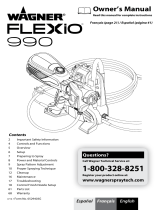 Wagner SprayTech Flexio 990 Sprayer Manuel utilisateur
Wagner SprayTech Flexio 990 Sprayer Manuel utilisateur
-
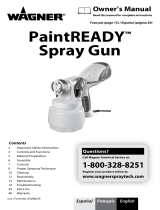 Wagner SprayTech PaintREADY Sprayer® Manuel utilisateur
Wagner SprayTech PaintREADY Sprayer® Manuel utilisateur
-
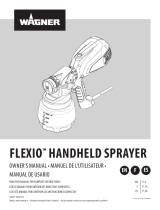 Wagner SprayTech FLEXiO 2100 and 2000 Plus Manuel utilisateur
Wagner SprayTech FLEXiO 2100 and 2000 Plus Manuel utilisateur
-
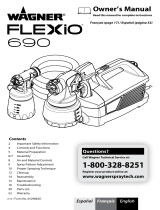 Wagner SprayTech Flexio 690 Sprayer Manuel utilisateur
Wagner SprayTech Flexio 690 Sprayer Manuel utilisateur
-
Wagner SprayTech PaintREADY System® Manuel utilisateur
-
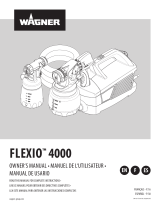 Wagner SprayTech FLEXiO 4000 Manuel utilisateur
Wagner SprayTech FLEXiO 4000 Manuel utilisateur
-
 Wagner SprayTech Flexio 2000 Le manuel du propriétaire
Wagner SprayTech Flexio 2000 Le manuel du propriétaire
-
Wagner SprayTech PROCOAT MAX Le manuel du propriétaire
-
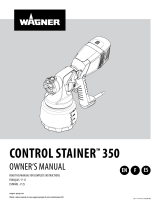 Wagner SprayTech Control Stainer 350 Manuel utilisateur
Wagner SprayTech Control Stainer 350 Manuel utilisateur
-
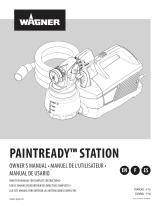 Wagner SprayTech PaintReady Station Sprayer Manuel utilisateur
Wagner SprayTech PaintReady Station Sprayer Manuel utilisateur
Autres documents
-
WAGNER 0529017 Le manuel du propriétaire
-
WAGNER FLEXiO 5000 Manual Manuel utilisateur
-
WAGNER 4-STEP ELECTRONIC PRO DUTY POWER PAINTER Le manuel du propriétaire
-
WAGNER Power Painter Le manuel du propriétaire
-
Earlex Finish Max Super Serie Le manuel du propriétaire
-
WAGNER WideShot Le manuel du propriétaire
-
WAGNER FLEXiO 5000 Manual Manuel utilisateur
-
WAGNER PRO DUTY POWER PAINTER Le manuel du propriétaire
-
WAGNER FLEXiO 4300 Paint Sprayer Manuel utilisateur
-
Campbell Hausfeld EZ5000 Series Manuel utilisateur































